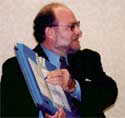Spring 2002
A Rush to Close Public Information
Orlando Sentinel Editor Tim Franklin addressed more than 100 participants in Tampa on Feb. 23 at the Pew/IRE workshop “Tapping New Data Territories.” Here are some highlights:
 If there’s one thing you could say about the people across America who were e-mailing me last March, it’s that they certainly weren’t mincing their words.
If there’s one thing you could say about the people across America who were e-mailing me last March, it’s that they certainly weren’t mincing their words.
“Look under your car before you get in,” suggested Bob Harker of Clarendon, NY. “Make sure the back door is locked. Look over your shoulder. Is this a death threat? Nah.”
Another e-mail writer, Marilyn Warga, dispensed with any pleasantries and got straight to her point. “Die! Die! Die! You sucker,” she commanded. “I want to see your autopsy photos now.”
… These e-mails – and thousands more – came from NASCAR fans nearly blind with rage over the Orlando Sentinel’s request to access the autopsy photos of racing icon Dale Earnhardt.
The majority of these fans were appalled that images of Earnhardt – sprawled on a steel coroner’s table – might be published in the Sentinel or placed on the Internet, for all the world to see.
Unquestionably, Earnhardt’s status as an American folk hero … fueled the emotional onslaught. But the intensity of their reaction was symbolic of a much larger issue.
A Volatile Confluence
There’s a volatile confluence in America today. Fundamental, democratic principles are bumping headlong into new technology. Here are the ingredients: a burgeoning privacy movement, an understandable concern about national security, the ever-widening reach of the Internet, and the right of the public to have access to the taxpayer-supported work of our government officials – a fundamental tenet of our democratic, self-governed society.
I believe we are at the crossroads of a watershed moment in our nation’s evolution, as our elected leaders and the courts react to set the boundaries of this new playing field in the Internet Age.
Because of concerns about privacy and national security – and the availability of information on the Internet – we are seeing an unprecedented rush to close information to the public. Essentially, the mood in the nation seems to have shifted from “the public has a right to know” to “how much does the public need to know?”
Indeed, the actions taken by our elected officials and the courts in the next few months could fundamentally alter how open the work of our government will be. The stakes for our citizens couldn’t be higher. And, regrettably, our industry has done little to inform our citizens or our elected representatives, how these changes could affect their lives.
I still have the bruises from my own controversial public records fight last year. So, I’d like to use that as a case study for these larger issues.
In the fall of 2000, the Sentinel set out to investigate why three NASCAR drivers – Adam Petty, Kenny Irwin and Tony Roper – had all died in race crashes in just a few short months. Was there a common link to the drivers’ deaths? If so, could anything have been done to prevent them? Or were these just three random, horrible accidents?
After six months of reporting, Ed Hinton, our auto-racing writer, determined the three drivers all died of a skull fracture caused by the violent whipping of their heads when their cars slammed into concrete retaining walls at high speeds.
Hinton also discovered something else: A head-and-neck restraint system, the HANS device, can prevent the very skull fracture the three drivers suffered. And while other professional racing leagues had mandated that drivers use the HANS device, NASCAR – America’s most popular racing organization – did not.
On Feb. 11, the first story in Hinton’s three-part series appeared: “NASCAR idles while drivers die; Racing officials fail to mandate lifesaving device.”
One week later, NASCAR’s biggest star was killed on the last turn of the last lap of the Daytona 500 … Earnhardt’s death was met with disbelief … but his death only intensified our resolve to find answers.
Early indications were that Earnhardt died from exactly the same injury as the other three drivers – a skull fracture caused by violent head whip.
But five days after the accident, NASCAR and Daytona’s chief doctor dropped a bombshell – they said Earnhardt’s seat belt had broken, an event almost unheard of in NASCAR’s history.
Either the seat belt and safety systems of NASCAR’s race cars were dangerously flawed, or the racing league was trying to divert public attention away from its failure to mandate a safety device that could have saved the sport’s brightest star.
The Sentinel immediately called medical experts. They all told us they couldn’t say how Earnhardt died without reviewing his autopsy photos. That’s why we filed our public records request – so that one of the nation’s top head trauma experts could examine Earnhardt’s autopsy photos and draft a report that would tell us not only how he died, but whether his death could have been prevented.
The day after we filed our request, Teresa Earnhardt’s attorney asked if we would consider a settlement. Would we agree not to publish the photos in return for gaining access to them? Yes, we said, because we didn’t want to publish the photos anyway.
Her attorney drafted an agreement, which we signed.
Then, inexplicably, Mrs. Earnhardt fired her attorney and hired a new one. Less than 48 hours later, without any contact from her or her attorney, she held a press conference to denounce the Sentinel on national television. She called on NASCAR fans to “let your voices be heard.”
Chaos ensued. The Sentinel was flooded with more than 15,000 angry e-mails, letters and telephone calls. Dozens of death threats poured in, several deemed serious enough to turn over to the Orlando police.
We had a major public relations problem on our hands. The vast majority of NASCAR fans mistakenly believed that we wanted to publish the autopsy photos. Very few had any idea that we had just spent six months investigating NASCAR driver safety. Meanwhile, the nation’s press clamored to cover this emerging courtroom drama … the Sentinel became the story.
We eventually reached a settlement with Mrs. Earnhardt. It allowed us to practice good journalism and to continue our investigation of NASCAR safety. It did not permanently seal Earnhardt’s autopsy photos, as her attorneys suggested.
It allowed Dr. Barry Myers of Duke University, a renowned head trauma expert, to examine the photos under court supervision, which addressed Teresa Earnhardt’s privacy concerns. Myers concluded that Earnhardt did, in fact, die from a skull fracture caused by violent head whip. He also concluded that a broken seat belt had not caused Earnhardt’s death.
Late last year, NASCAR mandated that drivers wear a head and neck restraint system … [and] black boxes, or crash data recorders, were mandated for all NASCAR race cars.
NASCAR issued its own report contradicting Myers’ findings and concluding that a broken seat belt had contributed to Earnhardt’s death.
Internet Reshapes Access
What does this case mean for the future of open records? First, we learned that when a debate involves open records versus privacy, especially the privacy of a beloved sports figure, the privacy forces are loud, powerful and, at times, threatening.
Second, we learned that public-access arguments have been forever reshaped by the Internet Age. Even after we got the message out that we had no intention of ever publishing Earnhardt’s autopsy photos, our critics still made the argument that they would end up on the Internet.
… Now, in the wake of the Sept. 11 terrorist attacks, we are confronted with a broad move toward secrecy and restricted public access that could reshape how Americans do business and monitor their government for decades.
Here are some stark facts, contained in a poll conducted in late 2000 by the American Society of Newspaper Editors and the First Amendment Center, months before Earnhardt’s death:
- Ninety percent of respondents supported open public records, but only 22 percent supported making them available on the Internet.
- Eighty-nine percent said they were concerned about their personal privacy, the same number as those who said they were concerned about crime.
- Sixty percent believed that laws guaranteeing privacy should be strengthened, even if Americans lose access to public records.
- Fifty-six percent would support tighter privacy laws, even if they hinder journalists.
Needless to say, the media industry has its face against the wind of public opinion at a critical moment in the history of our democracy, one brought on – in part – by a new medium still in its infancy. This may be a temporary problem fueled by people who are frightened by the Internet.
But lawmakers read polls … They have the opportunity to use the cover of privacy concerns to shut off access to all sorts of government records. Not only do they have the motivation of privacy, they also now have the political shelter of national security. While Earnhardt put into sharp focus the issue of privacy rights vs. public access, the terror attacks have thrust us into uncharted waters.
In Florida right now, a staggering 126 bills already have been introduced in the current legislative session to weaken – and in some cases completely gut – the state’s Sunshine Law.
… On the national level, federal agencies are imposing stricter standards in reviewing thousands of Freedom of Information requests.
Without question, we are living in uncertain times … Nobody wants terrorists to get a playbook to wreak havoc from public records.
But we also should be careful not to cede basic principles of our democracy, like open government. As an industry, we must get serious about this issue now. We must educate our readers about why open government and public records are critical to our way of life.
We must show real-life examples of how public records benefit the public. How crime records can help make neighborhoods safer. How hospital and nursing home records can be used to protect our loved ones who are sick or old. How public health records can identify and prevent the spread of disease. How real estate records can help people buying a home. And, how autopsy records can help experts and the media to prevent future injuries and death.
… This is a call to journalistic arms. We can’t remain complacent about these issues any more. If we are, we lose. And more importantly, our democracy and our people lose.
For Franklin’s entire address, click on: www.pewcenter.org/doingcj/speeches/s_franklin.html.

The Miami Herald’s Mark Seibel kicked off the workshop and demonstrated Florida’s famous butterfly ballot.

Tampa participants donned 3-D glasses to see how interactive images can apply to journalism.
